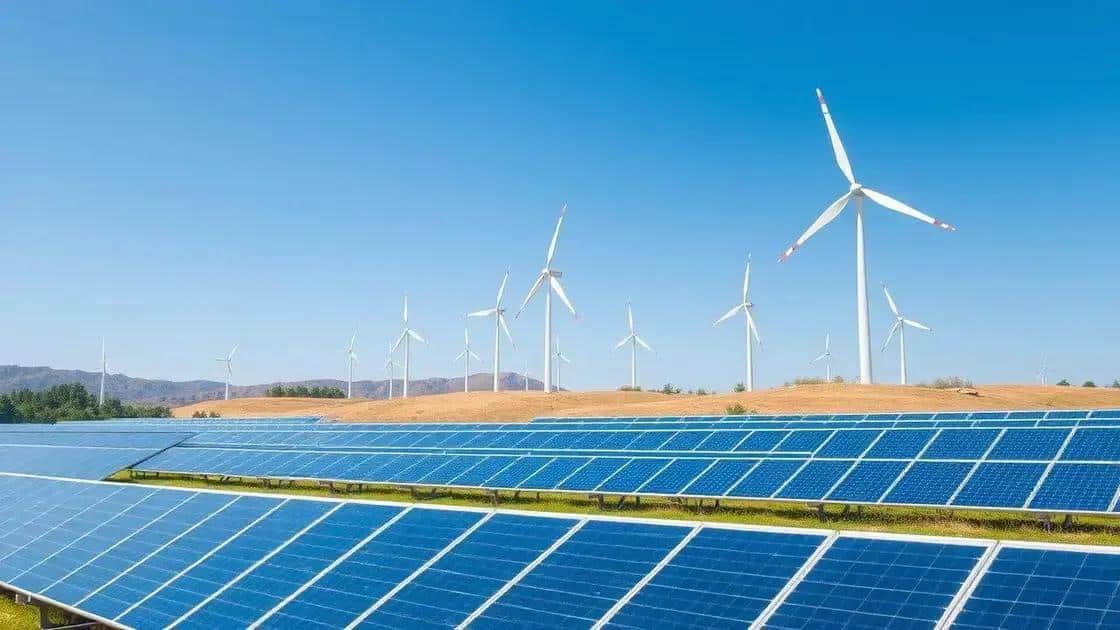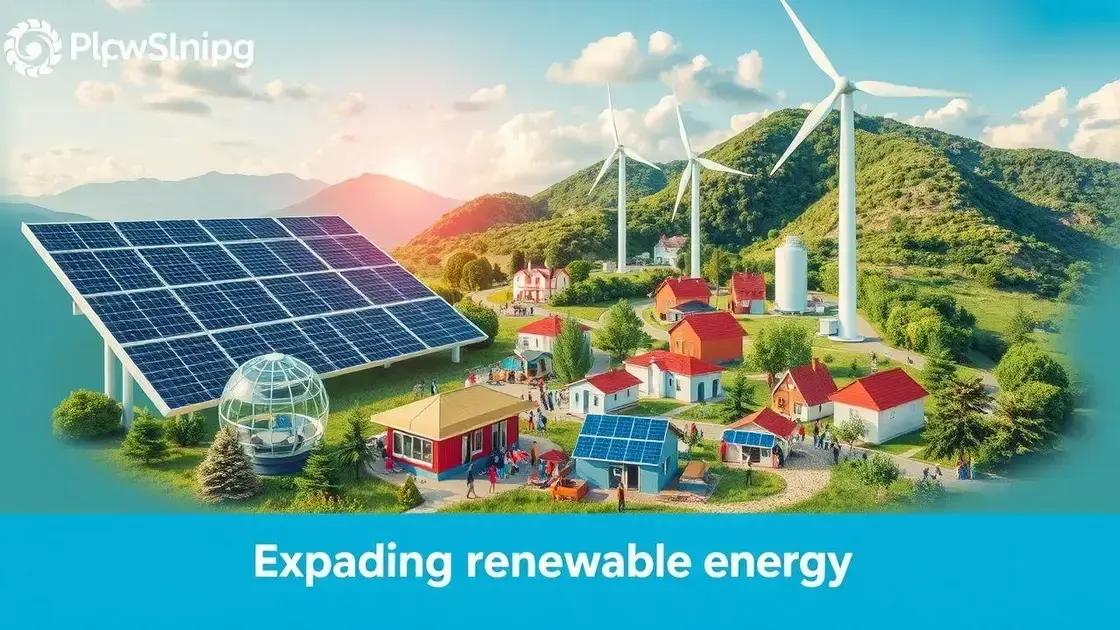Renewable energy expansion insights: navigating the future

The expansion of renewable energy addresses environmental challenges and boosts economic growth through innovative technologies, efficient energy storage, and smart grid solutions that enhance accessibility and reliability.
Renewable energy expansion insights are crucial for understanding how our planet can shift towards a more sustainable future. Have you ever wondered how these changes affect everyday life? In this article, we will explore the various dimensions of renewable energy, its benefits, and the obstacles we face.
Understanding renewable energy sources
Understanding renewable energy sources is essential for grasping how we can create a sustainable future. These sources harness natural processes to generate energy without depleting our planet’s resources. From solar to wind, each type contributes to reducing our carbon footprint and enhancing energy independence.
Types of Renewable Energy
There are various types of renewable energy sources, each offering unique benefits and challenges. Below are the main types:
- Solar Energy: Captured using solar panels, solar energy converts sunlight into electricity. It’s one of the most abundant energy sources available.
- Wind Energy: Wind turbines convert kinetic energy from the wind into power. This technology is growing rapidly across the globe, especially in windy regions.
- Hydro Energy: Generated from moving water, hydro energy relies on dams or river currents to produce electricity. It’s one of the oldest forms of renewable energy.
- Geothermal Energy: Utilizing heat from the Earth’s core, geothermal energy is a reliable and consistent energy source, particularly in volcanic regions.
Each of these sources contributes significantly to a reduction in greenhouse gas emissions. Transitioning to renewable energy can help mitigate climate change, protect ecosystems, and support economic growth by creating jobs in new energy sectors. Furthermore, many countries are investing heavily in research and development to improve the efficiency of renewable technologies.
Advantages of Renewable Energy
Switching to renewable energy offers numerous advantages. Not only does it reduce dependency on fossil fuels, but it also enhances national security by decreasing vulnerability to foreign energy markets. As these energy technologies continue to evolve, we will see improvements that may lower costs and increase accessibility.
In summary, the shift toward renewable energy is not just beneficial; it is essential for ensuring a sustainable and healthy planet for future generations. By understanding these energy sources, we can actively participate in this crucial transformation, making informed choices in our energy consumption.
The benefits of expanding renewable energy

There are numerous benefits to expanding renewable energy sources that can positively impact the environment, economy, and society. As we push for sustainable practices, understanding these advantages becomes crucial for fostering a cleaner and healthier planet.
Environmental Benefits
One of the foremost benefits of expanding renewable energy is its potential to reduce greenhouse gas emissions. Renewable sources like solar and wind produce electricity without burning fossil fuels. This means less pollution in our air and water, significantly lowering the risk of climate change.
- Reduced Air Pollution: Cleaner energy leads to improved air quality, which directly benefits public health.
- Conservation of Natural Resources: Renewable energy reduces the dependence on finite resources like coal and oil.
- Biodiversity Protection: Utilization of renewable sources minimizes habitat destruction compared to traditional energy practices.
As renewable energy technologies become more widespread, the prospect of creating a more sustainable future seems within reach. Transitioning to these energy sources not only benefits the environment but also fosters energy independence.
Economic Advantages
Expanding renewable energy can boost local economies. Investments made in this sector tend to enhance job creation, offering a wide range of employment opportunities. From manufacturing solar panels to installing wind turbines, these jobs often pay well and are less susceptible to offshoring than those in fossil fuel industries.
Additionally, renewable energy projects typically have lower operating costs once up and running. Once initial installations are completed, maintaining renewable energy sources is often cheaper than maintaining traditional power plants.
As the global market shifts towards more sustainable energy practices, countries investing in renewable technologies are likely to gain a competitive advantage. This can enhance their economic stability and allow for further innovation in energy efficiency.
Moreover, as communities adopt renewable energy solutions, they become part of a larger movement towards sustainability that supports international goals to combat climate change.
Challenges in the renewable energy sector
While the growth of renewable energy is promising, there are significant challenges that must be addressed to maximize its potential. Each challenge presents unique obstacles, but understanding them is the first step towards finding solutions.
Intermittency Issues
One major challenge in the renewable energy sector is intermittency. Sources like solar and wind are not always available due to changing weather conditions. This lack of a constant energy supply can lead to instability in energy grids. Utilities need to find ways to store energy or supplement it with other power sources during shortages.
- Storage Technologies: Developing efficient battery systems is essential for storing excess energy for later use.
- Grid Integration: Transitioning to smart grids can help manage energy flow more effectively.
- Diversification: Combining different renewable sources can create more stable power generation.
Addressing these intermittency issues is crucial to ensure a reliable energy supply as we transition away from fossil fuels.
High Initial Costs
Another challenge is the high initial investment required for renewable energy infrastructure. Setting up solar panels, wind turbines, and other technology can be costly. However, these investments often lead to lower operational costs over time, making them more financially viable in the long run.
Financial incentives from governments, such as subsidies and tax breaks, play an important role in encouraging the adoption of renewable energy. These policies aim to lower the overall cost barrier for both consumers and businesses.
Moreover, public perception of renewable energy can be affected by the initial expense. Many people may not realize how much they can save in the long term, which can hinder widespread adoption.
Regulatory and Policy Challenges
Regulatory frameworks also pose challenges to renewable energy. In many regions, outdated regulations favor traditional energy sources. To overcome this, policymakers must update laws to support renewable technologies. This involves creating fair competition among different energy sectors and ensuring clear guidelines for the development and integration of renewables.
Collaboration between governments, businesses, and communities is vital for overcoming these hurdles. Engaging stakeholders ensures that everyone’s needs are met as we move towards a renewable energy future.
Future trends and innovations in renewable energy

Future trends and innovations in renewable energy are shaping the way we think about energy consumption and sustainability. As technology advances, we can expect exciting developments that will enhance the efficiency and availability of renewable energy sources.
Advancements in Solar Technology
One significant area of innovation is in solar technology. Researchers are developing more efficient solar cells that can capture more sunlight and convert it into electricity. This includes improvements in materials, such as perovskite solar cells, which offer promise for greater efficiency at lower costs.
- Building-Integrated Photovoltaics (BIPV): Incorporating solar panels directly into building materials, allowing structures to generate energy without needing separate installations.
- Floating Solar Farms: Utilizing bodies of water for solar panels, reducing land usage and cooling the panels for better efficiency.
- Solar Tracking Systems: Technology that allows panels to follow the sun’s movement for optimal energy capture.
These advancements could make solar energy one of the most affordable and accessible energy sources worldwide.
Wind Energy Innovations
Similarly, the wind energy sector is seeing rapid innovation. New turbine designs are enhancing energy capture, making wind farms more efficient. Offshore wind energy, in particular, is gaining momentum as advancements in technology make it easier to install and maintain turbines in marine environments.
With larger turbines and improved materials, the potential for wind energy output is expanding. This means more clean energy for homes and businesses.
Additionally, integrating digital technologies like AI and IoT can optimize the performance and maintenance of wind farms by predicting potential issues before they occur.
Energy Storage Solutions
Another critical innovation is in energy storage solutions. As renewable energy production can be inconsistent, storing energy is vital for ensuring a reliable supply. Advances in battery technology, particularly lithium-ion and emerging alternatives like solid-state batteries, are crucial for efficient energy storage.
These innovations can provide backup power during low production periods and enable a smoother energy transition towards a fully renewable grid. Enhanced storage solutions will play a significant role in balancing energy demands with supply, allowing for increased reliance on renewables.
Smart Grids and Energy Management
Smart grids represent the future of energy distribution, integrating technology to optimize energy usage and management. These grids can analyze energy demand patterns and adjust distribution in real time, leading to higher efficiency and reduced waste.
Moreover, smart technologies empower consumers to monitor and manage their energy consumption, encouraging more sustainable practices and energy-saving behaviors. The rise of decentralized energy systems allows communities to generate and share power localized from renewable sources.
FAQ – Frequently Asked Questions about Renewable Energy
What are the main benefits of renewable energy?
Renewable energy sources help reduce greenhouse gas emissions, improve air quality, and provide energy independence while creating jobs and boosting local economies.
What challenges does the renewable energy sector face?
Key challenges include intermittency of energy supply, high initial costs, regulatory barriers, and the need for improved energy storage solutions.
How can technological advancements improve renewable energy?
Innovations in solar panels, wind turbines, and energy storage technologies enhance efficiency and lower costs, making renewable energy more accessible.
What role do smart grids play in renewable energy?
Smart grids optimize energy distribution, allowing for better management of renewable energy sources and improving overall energy efficiency.





